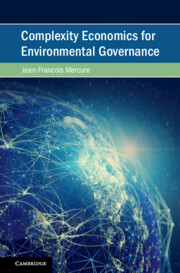Book contents
- Frontmatter
- Contents
- Figures
- Tables
- Preface
- Acknowledgements
- Part I The State of Knowledge and its use in Environmental Economics
- Part II A Positive Theory for Complexity Economics
- 5 Concepts of Complexity for Economics
- 6 Fundamental Uncertainty
- 7 Micro-foundations for Consumer Theory
- 8 Micro-foundations for an Economic Theory of Innovation
- 9 Empirical Foundations for the Nature of Money
- 10 Micro-foundations for Credit Creation and the Business Cycle
- 11 A Macroeconomic Model for Growth and Creative Destruction
- Part III Applied Complexity Economics for Environmental Governance
- References
- Index
10 - Micro-foundations for Credit Creation and the Business Cycle
from Part II - A Positive Theory for Complexity Economics
Published online by Cambridge University Press: 03 November 2022
- Frontmatter
- Contents
- Figures
- Tables
- Preface
- Acknowledgements
- Part I The State of Knowledge and its use in Environmental Economics
- Part II A Positive Theory for Complexity Economics
- 5 Concepts of Complexity for Economics
- 6 Fundamental Uncertainty
- 7 Micro-foundations for Consumer Theory
- 8 Micro-foundations for an Economic Theory of Innovation
- 9 Empirical Foundations for the Nature of Money
- 10 Micro-foundations for Credit Creation and the Business Cycle
- 11 A Macroeconomic Model for Growth and Creative Destruction
- Part III Applied Complexity Economics for Environmental Governance
- References
- Index
Summary
In this chapter, a self-organised criticality model of financial networks is developed mathematically and is applied computationally. It first establishes a complex network model of the equity identity of balance sheets. This is used to simulate various possible modes of operation of the financial system under different levels of stress and states of criticality, according to the distributions of the distance to insolvency of financial agents. This model can explain how the economy amplifies some small fluctuations into large scale financial crashes. It explains when and how the economy may be vulnerable to instability according to the topology of its financial network, and its distance to criticality according to the quantity of leverage that its financial agents have undertaken. Lastly, it identifies policy instruments effective at controlling the rate of growth of borrowing, systemic risk accumulation and collective risk-taking.
- Type
- Chapter
- Information
- Complexity Economics for Environmental Governance , pp. 252 - 273Publisher: Cambridge University PressPrint publication year: 2022

